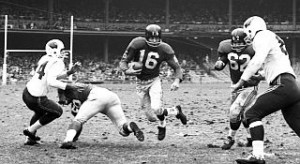Waiting for the Weekend: Is the NFL Really in Trouble This Time?

A recent study of the brains of former NFL players showed almost all had some level of brain trauma.
For the last year or more, it seems every time there is a negative story about the NFL, it prompts the obligatory question of whether that particular issue will be the proverbial “straw that broke the camel’s back” and signal the start of the decline for the financial and popularity juggernaut.
Whether it be declining television ratings, continued off-the-field incidents by players, the perception by many that the game isn’t as physical as in past, the abandonment of long-time NFL cities in St. Louis, San Diego and Oakland, the general unpopularity of Roger Goodell and the New England Patriots or a number of other “negative” stories or events, they all seem to just roll off the back of the NFL as overall revenues continue to increase to levels envied by most governments or for-profit businesses.
However, news that came out this week may over time be the one story that the NFL cannot easily shake.
A scientific study published this week in the medical journal JAMA looked at the brains of 202 deceased former high school, college and professional football players. Amongst those former players, 177, including 110 of the 111 former NFL players, were diagnosed as having CTE (Chronic Traumatic Encephalopathy).
CTE is a degenerative brain disease most often found in athletes, military veterans, and others with a history of repetitive brain trauma. To create CTE, a protein called Tau forms clumps that slowly spread throughout the brain, killing brain cells. Studies have found CTE in people as young as 17, but symptoms most typically don’t begin appearing until years after the initial head impacts.
Early symptoms of CTE affect a patient’s mood and behavior. Some common changes often include impulse control problems, aggression, depression, and paranoia.
As the disease progresses, it is typical for patients to experience problems with thinking and memory, including memory loss, confusion, impaired judgment, and eventually progressive dementia. Cognitive symptoms tend to appear later than mood and behavioral symptoms, and often first appear when the patient is in their 40s or 50s. Patients may exhibit one or both symptom clusters and the symptoms may often worsen with time (even if the patient suffers no additional head impacts). In other cases, symptoms may be stable for years before worsening.
For many years, the NFL refused to recognize that there was the potential for a direct connection between football and diseases that impact the brain.
It has only been within the last few years that the NFL has tried to get ahead of the issue, and of course, being that they are generally all about money, they have done so primarily by trying to buy their way to redemption and resolution.
The NFL has pledged $100,000 towards brain research, though that has been wrought with controversy as initially much of their support was directed to doctors that mitigated the impact of football on CTE and long-term brain illness.
They also have been attempting to settle a billion dollar lawsuit by former players related to brain trauma and other healthcare issues. The settlement would provide up to $5 million to players who meet certain eligibility standards, but critics have been very quick to point out that the settlement is very limiting and would meet the needs of only a handful of players compared to those with long-term health issues.
All of this has brought the issue of brain trauma to the forefront for the NFL, but until recently all seem to have been only minimally impacting the NFL’s reputation and perception.
The NFL has made “player health” a priority in recent years and have made some very public attempts to try and show that they are making the game “safer”. However, while there have been definite efforts in some areas, in others it seems like the NFL is in general using the idea of “player safety” when it is especially convenient for them, but not when it has the potential to threaten their multi-billion dollar industry.
One thing that hurts the perception of the NFL around the issue of brain trauma is that the players being mentioned around the issue of CTE are well-known and in some cases beloved figures from the history of the game.
Among the players included in this study were Hall of Fame quarterback Ken Stabler, well-known actor and Lite Beer advertiser Bubba Smith as well as former Chicago Bears star Dave Duerson and former fullback Kevin Turner, who had a very public battle with Lou Gehrig’s Disease. Other well-known former players whose brains reportedly contained CTE include Hall of Famer player and broadcaster Frank Gifford, Hall of Famer Junior Seau and former New York Giants defensive back Tyler Sash.
While CTE can only formally be diagnosed after death, many other former NFL players have publicly stated that they are suffering some level of brain trauma and memory issues. Those ranks have included Hall of Fame running back Tony Dorsett and former Chicago Bears quarterback Jim McMahon.
One of the major concerns the NFL has around the player safety issue is the potential long-term impact to their development base of future players.
There has been a decline in the number of youth participating in tackle football over the last decade. Certainly some of that is attributable to concern over the safety of children, though the increasing popularity of other sports, most especially soccer, also have played a role.
The NFL has introduced youth football teaching programs to try and help teach coaches how to improve safety for youth players. However, it seems like every year ESPN or some other network highlights a youth program where they show eight year olds tackling each other head-on with all the power they can muster.
In recent years a number of young NFL players who seemed to be in the prime of their careers and in some cases heading to NFL stardom have cited safety issues among their reasons for early retirement.

Math whix and Baltimore Ravens offensive lineman John Urschel has chosen to retire from football, rather than risk long-term brain trauma.
The most recent occurred this week when Baltimore Ravens offensive lineman John Urschel, who is currently pursuing a doctorate degree in Mathematics at MIT, announced two days after the release of the most recent study that he was retiring immediately.
Just a few months ago, Urschel told reporters that he was aware and accepting of the health risks associated with his profession, but at the time felt his enjoyment of the game out-paced his concern. He made that statement even as he described his own situation when a concussion noticeably impacted his ability to utilize his math talents for several weeks.
Though Urschel was not a superstar and wasn’t guaranteed of even being a starter this season for the Ravens, the NFL had used him as a poster-child to illustrate that football players were not just a bunch of “dumb jocks.”
Some experts have predicted that over time the population that turns away from allowing their children to play football will likely be more financially affluent, while families who might see football as a way for their children to taste celebrity and financial security would be more willing to accept the risks.
It has been referred to as a “gladiator mentality” where eventually you have the economically poor playing this violent game while those with wealth and affluence watch.
If we ever did get to that state, a real question would be whether the NFL would continue to enjoy the popularity and financial power that it has today.
We all know that 100 years ago boxing was among the most popular sports in America. The upcoming Mayweather vs. McGregor fight not withstanding, the popularity of boxing has dramatically declined over the last 50 years to the point where it is most often relegated to second level of interest and only a handful of youth, often from poor and inner-city areas are still turning to it as a potential escape.
The NFL has been amazingly resilient in crushing all the potential pitfalls to its goal of being a $25 billion dollar annual empire. Player health and safety is an issue that certainly could threaten that financial success, but given the track-record for the NFL to overcome its negatives, it will likely take many more setbacks even greater than the recent CTE study for the game to take a drastic fall.

Hey fantastic website! Does running a blog like this take a massive amount work?
I have very little understanding of computer programming but I had been hoping to start my own blog soon. Anyway,
should you have any ideas or tips for new blog owners please share.
I understand this is off subject however I simply had to
ask. Thanks!